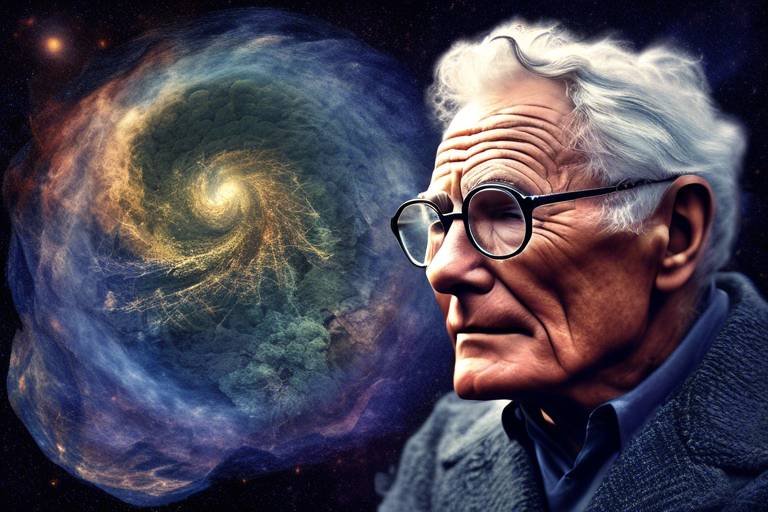The Life of Gerty Cori and Biochemistry
Gerty Cori was not just a name in the annals of science; she was a pioneer, a trailblazer who broke through the barriers of gender and societal expectations to make groundbreaking contributions to biochemistry. Born in 1896 in Prague, she grew up in an environment that encouraged learning and curiosity. Her early exposure to science and the arts laid a strong foundation for her future endeavors. But what truly set her apart was her relentless passion for understanding the complexities of life at a molecular level.
As we delve into the remarkable journey of Gerty Cori, we discover a story filled with determination, innovation, and a profound impact on both science and medicine. Her work not only advanced our understanding of carbohydrate metabolism but also paved the way for significant advancements in the treatment of diseases such as diabetes. In a time when women were often sidelined in the scientific community, Gerty stood tall, proving that passion and intellect know no gender.
Throughout her career, Gerty faced numerous challenges, yet she remained undeterred. Her partnership with her husband, Carl Cori, was not just a romantic relationship; it was a powerful scientific collaboration that led to many of their shared discoveries. Together, they explored the intricate pathways of energy metabolism, ultimately leading to the formulation of what we now know as the Cori Cycle—a concept that is fundamental to our understanding of how the body utilizes energy during physical activity.
But Gerty's influence extends beyond her scientific achievements. She became a mentor and a role model for countless women aspiring to make their mark in the sciences. Her legacy is a testament to the importance of perseverance and passion in the pursuit of knowledge. As we celebrate her life and contributions, we are reminded of the hurdles she overcame and the doors she opened for future generations of female scientists.
In this article, we will explore Gerty Cori's early life, her scientific breakthroughs, and the lasting legacy she left behind. Her story is not just about biochemistry; it is about the power of resilience and the impact one individual can have on the world. So, let’s embark on this journey to uncover the incredible life of Gerty Cori and her monumental contributions to the field of biochemistry.
- What were Gerty Cori's main contributions to biochemistry?
Gerty Cori's primary contributions include her research on carbohydrate metabolism and the discovery of the Cori Cycle, which describes how the body processes glucose during exercise.
- How did Gerty Cori impact women's roles in science?
Gerty Cori served as a role model and mentor for women in science, demonstrating that women could excel in fields traditionally dominated by men.
- What is the Cori Cycle?
The Cori Cycle is a metabolic pathway that describes how lactate produced in muscles during anaerobic respiration is converted back to glucose in the liver.

Early Life and Education
Gerty Cori, born on August 15, 1896, in Prague, was destined for greatness from the very start. Growing up in a family that valued education, she was exposed to a wealth of knowledge and intellectual curiosity. Her father, a lawyer, and her mother, a teacher, fostered an environment ripe for learning. This nurturing atmosphere played a critical role in shaping Gerty's scientific aspirations. From an early age, she exhibited a keen interest in the natural sciences, often experimenting with various materials and asking profound questions about the world around her.
As a young girl, Gerty was not just an ordinary student; she was a bright star in her school, often outshining her peers. Her passion for science led her to enroll at the German University in Prague, where she pursued a degree in chemistry. The academic rigor she faced was daunting, yet it only fueled her determination to excel. Gerty was a trailblazer, navigating a male-dominated field with grace and resilience. She earned her doctorate in 1920, becoming one of the few women of her time to achieve such a feat.
During her university years, Gerty was influenced by several prominent scientists who would leave a lasting impression on her career. Among them was the renowned biochemist Otto Warburg, whose work in cellular respiration and energy metabolism inspired her own research interests. Gerty's education was not just confined to textbooks; she engaged in practical laboratory work, where she honed her skills and developed a robust understanding of biochemical processes.
After completing her doctorate, Gerty faced significant challenges in her pursuit of a scientific career. Opportunities for women in research were limited, and she often encountered skepticism from her male counterparts. Nevertheless, her unwavering commitment to science and her groundbreaking research would soon change the narrative for women in the field. Gerty Cori's early life and education laid the foundation for her future achievements, instilling in her the belief that she could make a meaningful impact in the world of biochemistry.

Scientific Breakthroughs
Gerty Cori's journey through the world of biochemistry was nothing short of a scientific odyssey, marked by groundbreaking discoveries that reshaped our understanding of carbohydrate metabolism. Her work not only illuminated the intricate processes that govern energy production in the body but also paved the way for future research in various fields, including medicine and nutrition. One of her most significant contributions was her investigation into how the body processes glycogen, a stored form of glucose that plays a crucial role in energy regulation.
At the heart of her research was the discovery of the Cori Cycle, a revolutionary concept that describes the metabolic pathway through which lactate produced by muscles during intense exercise is converted back into glucose in the liver. This cycle not only highlights the body’s efficiency in energy management but also underscores the importance of understanding metabolic pathways in the context of physical performance and recovery. Imagine your muscles working hard, producing energy, and then having a clever system in place to recycle that energy—this is exactly what Cori's findings illustrated.
Moreover, Gerty Cori's meticulous experiments and analyses provided insights into the mechanisms of glycogen metabolism. She explored how glycogen is synthesized and broken down, revealing the enzymatic processes involved. This research was pivotal, as it helped to clarify the roles of specific enzymes in these metabolic pathways. To better understand her contributions, consider the following table that summarizes the key enzymes involved in glycogen metabolism:
| Enzyme | Function |
|---|---|
| Glycogen Synthase | Facilitates the synthesis of glycogen from glucose |
| Glycogen Phosphorylase | Breaks down glycogen into glucose-1-phosphate |
| Debranching Enzyme | Removes branches in glycogen for efficient breakdown |
Through her innovative research, Gerty Cori not only advanced the field of biochemistry but also laid the groundwork for understanding conditions such as diabetes. Her findings on glycogen metabolism have had profound implications for diabetes research, revealing how imbalances in these metabolic processes can lead to chronic conditions. By elucidating the biochemical pathways that govern energy metabolism, she opened doors for new treatments and management strategies for diabetes, illustrating the far-reaching impact of her work.
In essence, Gerty Cori's scientific breakthroughs were not just about discovering new facts; they were about connecting the dots in a complex biological puzzle. Her ability to synthesize information and present it in a way that was actionable for future research has solidified her legacy in the scientific community. Today, her work continues to inspire a new generation of scientists who strive to unravel the mysteries of biochemistry, proving that curiosity and perseverance can lead to remarkable discoveries.
- What is the Cori Cycle? The Cori Cycle describes the process where lactate produced by muscles during exercise is converted back to glucose in the liver, playing a crucial role in energy metabolism.
- How did Gerty Cori contribute to diabetes research? Gerty Cori's research on glycogen metabolism provided insights into how metabolic imbalances can lead to diabetes, influencing treatment and management strategies.
- Why is glycogen metabolism important? Glycogen metabolism is essential for regulating energy levels in the body, particularly during physical activity, and understanding it can help in managing conditions like diabetes.

The Cori Cycle
The Cori Cycle is one of those brilliant discoveries that not only changed the landscape of biochemistry but also gave us profound insights into how our bodies manage energy. Imagine your body as a bustling city, where energy is the currency that keeps everything running smoothly. Just like any city, there are times when energy production and consumption need to be perfectly synchronized to avoid chaos. This is where Gerty Cori's groundbreaking work comes into play.
In essence, the Cori Cycle describes a metabolic pathway that involves the conversion of lactate produced in the muscles during intense exercise back into glucose in the liver. When you're exercising hard, your muscles can't get enough oxygen to burn glucose completely, leading to the production of lactate. Instead of just letting this byproduct sit around, your body cleverly turns it into something useful, sending it to the liver where it can be transformed back into glucose through a process called gluconeogenesis. This glucose can then be sent back to the muscles, providing them with the energy needed to keep going.
To put it simply, think of the Cori Cycle as a recycling program for energy. Just like how recycling helps reduce waste and repurpose materials, the Cori Cycle helps your body make the most out of the energy it produces. This cycle is crucial during high-intensity activities like sprinting or weightlifting, where energy demands spike and the body needs to adapt quickly.
Here's a basic overview of how the Cori Cycle works:
| Step | Process | Location |
|---|---|---|
| 1 | Production of Lactate | Muscles |
| 2 | Lactate Transport to Liver | Bloodstream |
| 3 | Conversion to Glucose | Liver |
| 4 | Glucose Released into Bloodstream | Liver |
| 5 | Glucose Uptake by Muscles | Muscles |
This cycle not only helps in maintaining energy levels during strenuous activities but also plays a significant role in metabolic conditions. For instance, understanding the Cori Cycle has been fundamental in developing strategies for managing conditions like diabetes and lactic acidosis. It underscores the importance of metabolic flexibility—the ability of the body to switch between different energy sources depending on the situation.
Moreover, the implications of the Cori Cycle extend beyond just athletic performance. It highlights how our bodies are equipped with intricate systems that manage energy efficiently, ensuring that we can perform daily activities without running out of fuel. Gerty Cori's work in elucidating this cycle not only earned her a place in the annals of scientific history but also paved the way for further research into energy metabolism and its implications for health and disease.

Mechanisms of Glycogen Metabolism
The intricate dance of glycogen metabolism is a fascinating process that underscores the brilliance of Gerty Cori's research. Glycogen, a polysaccharide stored primarily in the liver and muscles, serves as a vital energy reserve for our bodies. When energy demands increase, glycogen is broken down into glucose through a process called glycogenolysis. Conversely, when there’s an excess of glucose, it gets converted back into glycogen through glycogenesis. Cori's groundbreaking work elucidated these metabolic pathways, revealing how our body efficiently manages energy storage and expenditure.
At the core of glycogen metabolism are several key enzymes that facilitate these transformations. For instance, the enzyme glycogen phosphorylase plays a crucial role in glycogenolysis by cleaving glucose units from glycogen, releasing them into the bloodstream as glucose-1-phosphate. This is particularly important during periods of fasting or intense physical activity when the body requires rapid energy. On the flip side, the enzyme glycogen synthase is responsible for glycogenesis, catalyzing the addition of glucose units to form glycogen when energy is abundant.
Furthermore, Gerty Cori's research highlighted the impact of hormones on these processes. Insulin, for instance, promotes glycogenesis, signaling the body to store excess glucose as glycogen. Conversely, glucagon triggers glycogenolysis, ensuring that glucose is available during times of need. This hormonal regulation is crucial for maintaining blood sugar levels, showcasing how Cori’s work has implications not just for basic science, but also for understanding metabolic disorders.
To better understand the mechanisms, let's take a closer look at the metabolic pathways involved in glycogen metabolism:
| Process | Key Enzymes | Function |
|---|---|---|
| Glycogenolysis | Glycogen Phosphorylase | Breaks down glycogen into glucose-1-phosphate |
| Glycogenesis | Glycogen Synthase | Converts glucose to glycogen for storage |
Understanding these mechanisms is not just an academic exercise; it has real-world implications. For example, in individuals with diabetes, the regulation of glycogen metabolism is disrupted, leading to challenges in managing blood glucose levels. Gerty Cori's pioneering work laid the groundwork for further research into these metabolic pathways, ultimately contributing to the development of treatments that help stabilize glucose levels in diabetic patients.
In summary, Gerty Cori's exploration of the mechanisms of glycogen metabolism has had a profound impact on our understanding of energy management in the body. Her insights continue to resonate in the fields of biochemistry and medicine, reminding us of the intricate balance our bodies maintain to ensure we have the energy we need, when we need it.
- What is glycogen? Glycogen is a stored form of glucose, primarily found in the liver and muscles, which serves as an energy reserve for the body.
- How does glycogen metabolism work? Glycogen metabolism involves two main processes: glycogenolysis, which breaks down glycogen into glucose, and glycogenesis, which synthesizes glycogen from glucose.
- Why is Gerty Cori significant in biochemistry? Gerty Cori made groundbreaking contributions to our understanding of carbohydrate metabolism, particularly through her research on glycogen metabolism, influencing both science and medicine.

Impacts on Diabetes Research
Gerty Cori's groundbreaking work in biochemistry has had profound implications for diabetes research, a field that continues to evolve and expand today. Her discoveries not only illuminated the intricate processes of carbohydrate metabolism but also provided critical insights into how the body regulates blood sugar levels. By understanding these mechanisms, scientists have been better equipped to tackle the complexities of diabetes, a chronic condition affecting millions globally.
One of the most significant contributions Gerty made was through her exploration of the Cori Cycle, which elucidates how the body converts glycogen into glucose during times of energy demand. This cycle is crucial for maintaining blood sugar levels, especially during physical activity. Imagine the body as a well-oiled machine; when the fuel (glucose) runs low, it needs a reliable system to replenish it quickly. Gerty's research provided the blueprint for this system, allowing for a deeper understanding of how energy is mobilized and stored in the body.
Furthermore, Gerty Cori's work has paved the way for advancements in diabetes treatments. Her findings have influenced the development of medications that target glucose metabolism, leading to better management of blood sugar levels in diabetic patients. For instance, the understanding of glycogen metabolism has been foundational in creating therapies that help regulate insulin and glucose levels, effectively improving the quality of life for those living with diabetes.
In addition to her research, Gerty's legacy extends to the training and mentorship of future scientists in the field of diabetes research. She inspired countless students and researchers to dive into biochemistry, emphasizing the importance of rigorous scientific inquiry. Her influence can be seen in the numerous studies and clinical trials that continue to build upon her foundational work.
To illustrate the impact of Gerty Cori's research on diabetes, consider the following table that highlights the key areas of her contributions:
| Contribution | Impact on Diabetes Research |
|---|---|
| The Cori Cycle | Enhanced understanding of glucose production and energy metabolism. |
| Glycogen Metabolism | Informed the development of treatments targeting blood sugar regulation. |
| Mentorship | Encouraged future generations to pursue research in diabetes and biochemistry. |
In summary, Gerty Cori's contributions to biochemistry have had a lasting impact on diabetes research. Her work has not only advanced our understanding of metabolic processes but has also influenced the development of effective treatments for diabetes, showcasing the vital role of scientific research in addressing public health challenges.
- What was Gerty Cori's main contribution to biochemistry?
Gerty Cori is best known for her research on carbohydrate metabolism, particularly the Cori Cycle, which describes how the body converts glycogen into glucose. - How did Gerty Cori's work impact diabetes research?
Her discoveries provided critical insights into glucose regulation and metabolism, influencing the development of diabetes treatments and therapies. - What legacy did Gerty Cori leave for future scientists?
Gerty Cori inspired many through her mentorship and dedication to scientific inquiry, paving the way for women in science and encouraging future research in biochemistry.

Recognition and Awards
Gerty Cori's remarkable journey in the world of science was not just marked by her groundbreaking discoveries, but also by the numerous accolades she received throughout her illustrious career. Her contributions to biochemistry, particularly in carbohydrate metabolism, earned her a place among the most esteemed scientists of her time. It was as if she was a comet streaking across the scientific sky, illuminating the path for others to follow.
One of the most significant recognitions Gerty received was the Nobel Prize in Physiology or Medicine in 1947, which she shared with her husband, Carl Cori. This prestigious award was a testament to their collaborative work on the Cori Cycle, an essential process in energy metabolism. Winning a Nobel Prize is akin to being crowned the champion in a global competition; it signifies that your work has fundamentally changed the landscape of your field.
In addition to the Nobel Prize, Gerty Cori was honored with several other accolades that reflected her influence in the scientific community. Some of these include:
- Member of the National Academy of Sciences - This membership is one of the highest honors a scientist can achieve in the United States, recognizing her outstanding contributions to science.
- First woman to receive a Ph.D. in Chemistry from the University of Prague - This achievement was not just a personal milestone but a significant step forward for women in the sciences.
- Honorary Doctorates from various institutions - These honors were bestowed upon her by universities recognizing her groundbreaking work and influence in biochemistry.
Furthermore, Gerty Cori's legacy extends beyond her own accolades. She became a mentor and role model for countless female scientists, encouraging them to pursue their passions in a field that was predominantly male. Her story serves as a beacon of hope, proving that with determination and hard work, barriers can be broken. In many ways, Gerty was like a lighthouse guiding aspiring scientists through the fog of doubt and discrimination.
In recognition of her contributions, various awards and scholarships have been named in her honor, ensuring that her legacy will continue to inspire future generations. Just as the ripples from a stone thrown into a pond spread far and wide, Gerty Cori's impact on science and society continues to resonate today.
In summary, Gerty Cori's numerous awards and recognitions not only highlight her exceptional scientific achievements but also underscore her role as a pioneer for women in science. Her life's work remains a powerful reminder that the pursuit of knowledge knows no gender and that every contribution, no matter how small, can lead to monumental change.
1. What was Gerty Cori's most significant contribution to science?
Gerty Cori's most significant contribution was her work on the Cori Cycle, which describes how the body metabolizes carbohydrates for energy. This discovery has had profound implications for understanding energy metabolism and exercise physiology.
2. Did Gerty Cori work alone on her research?
While Gerty Cori was a brilliant scientist in her own right, she often collaborated with her husband, Carl Cori. Together, they made significant advancements in biochemistry, particularly in understanding carbohydrate metabolism.
3. How did Gerty Cori influence women in science?
Gerty Cori's achievements paved the way for women in science by breaking gender barriers and serving as a role model. Her success demonstrated that women could excel in scientific fields, encouraging many to pursue their own careers in science.
4. What awards did Gerty Cori receive during her lifetime?
Gerty Cori received numerous awards, including the Nobel Prize in Physiology or Medicine, membership in the National Academy of Sciences, and honorary doctorates from various universities.

Legacy and Influence
Gerty Cori's legacy is not just a footnote in the annals of biochemistry; it is a vibrant chapter that continues to inspire and inform the scientific community today. Her groundbreaking work in carbohydrate metabolism has paved the way for numerous advancements in both science and medicine. But what truly sets her apart is her role as a trailblazer for women in science. In a time when female scientists were often overlooked, Gerty stood tall, challenging societal norms and proving that women could excel in the complex world of biochemistry.
Her achievements have left an indelible mark on the field, and they serve as a beacon for aspiring scientists, particularly women. The impact of her work extends beyond just her discoveries; it encompasses her ability to inspire future generations. Gerty Cori's story is a reminder that with passion, perseverance, and a bit of courage, one can break barriers and achieve greatness.
One of the most profound aspects of Gerty's legacy is her influence on educational institutions and research programs. Her commitment to science and education has encouraged universities to foster inclusive environments where women can thrive. Today, many programs are dedicated to supporting women in STEM, and much of this can be traced back to pioneers like Gerty Cori.
In recognition of her contributions, numerous awards and scholarships have been established in her name. These honors not only celebrate her achievements but also aim to encourage young women to pursue careers in science. For instance, the Gerty Cori Scholarship is awarded to female students who demonstrate exceptional promise in biochemistry, further ensuring that her legacy lives on.
Moreover, Gerty's research principles are still relevant in contemporary studies. Her findings on carbohydrate metabolism have laid the groundwork for modern medical research, particularly in understanding metabolic diseases. Today’s researchers continue to build on her work, exploring new avenues in diabetes treatment and other metabolic disorders. The significance of her contributions can be encapsulated in the following table:
| Area of Influence | Impact |
|---|---|
| Women in Science | Inspiration for future generations, establishment of scholarships |
| Carbohydrate Metabolism | Foundation for modern research in metabolic diseases |
| Education | Encouragement of inclusive environments in STEM fields |
In conclusion, Gerty Cori's legacy is a multifaceted tapestry woven from her scientific achievements and her unwavering commitment to promoting women in science. Her influence is felt not only in laboratories but also in classrooms and beyond, inspiring countless individuals to chase their dreams in the scientific realm. As we continue to unravel the mysteries of biochemistry, we do so on the shoulders of giants like Gerty Cori, whose contributions will forever resonate in the field.
- What was Gerty Cori's most significant contribution to biochemistry? Gerty Cori is best known for her work on carbohydrate metabolism, particularly the Cori Cycle, which describes how glucose is converted to energy in the body.
- How did Gerty Cori impact women in science? Gerty Cori broke barriers for women in science during her time, serving as a role model and mentor, and her legacy continues to inspire women in STEM fields today.
- What awards did Gerty Cori receive? Throughout her career, Gerty received numerous accolades, including the Nobel Prize in Physiology or Medicine in 1947, recognizing her contributions to biochemistry.
- Why is Gerty Cori still relevant today? Her research laid the groundwork for modern studies in metabolism and diabetes, making her findings crucial for ongoing medical research and advancements.

Women in Science
Gerty Cori was not just a brilliant scientist; she was a trailblazer for women in the field of science, a realm that was predominantly male during her time. Born in 1896 in Prague, her journey into the world of biochemistry was fraught with challenges, yet she emerged as a beacon of hope and inspiration for aspiring female scientists. Gerty's determination and passion for science allowed her to break through societal barriers, proving that women could excel in scientific endeavors just as well as their male counterparts.
Throughout her career, Gerty faced numerous obstacles, from gender bias to the struggle for recognition in a male-dominated field. However, she did not let these challenges deter her. Instead, she used her experiences to motivate other women, highlighting the importance of perseverance and resilience. Her success story serves as a powerful reminder that determination can lead to groundbreaking achievements, even in the face of adversity.
Gerty Cori's legacy extends beyond her scientific contributions; she became a role model for countless women. Her achievements encouraged many to pursue careers in science, paving the way for future generations. The impact of her work can be seen in the increasing number of women entering the fields of biochemistry, medicine, and research today. She showed that the lab coat is not just a symbol of science but also a garment that women can wear with pride.
In recognition of her contributions, Gerty received numerous accolades, including the Nobel Prize in Physiology or Medicine in 1947, which she shared with her husband, Carl Cori. This historic achievement was not just a personal victory for Gerty but a significant milestone for women in science, showcasing that female scientists could achieve greatness on par with their male colleagues. Her story is a testament to the changing tides in the scientific community, where women are increasingly recognized for their contributions.
Moreover, Gerty's influence is still felt today. Many organizations and initiatives aim to support and promote women in science, inspired by pioneers like her. Programs that encourage young girls to explore STEM fields (Science, Technology, Engineering, and Mathematics) are crucial in nurturing the next generation of female scientists. Gerty Cori's legacy is a reminder that the path she forged is one that continues to inspire and empower women to follow their passions in science.
As we reflect on Gerty Cori's life and work, it becomes clear that her contributions were not just limited to her scientific discoveries. She opened doors for women in science, showing that with hard work and determination, anything is possible. Her story is one of resilience, inspiration, and a profound reminder that the future of science is brighter when women are at the forefront.
- What were Gerty Cori's major contributions to science? Gerty Cori is best known for her work on carbohydrate metabolism and the Cori Cycle, which explains how the body processes glycogen.
- How did Gerty Cori influence women in science? Gerty Cori's achievements and recognition paved the way for future generations of women in science, inspiring many to pursue careers in STEM fields.
- What awards did Gerty Cori receive during her career? Gerty received several prestigious awards, including the Nobel Prize in Physiology or Medicine in 1947, recognizing her groundbreaking research.
- Why is Gerty Cori considered a trailblazer? Gerty Cori broke through gender barriers in a male-dominated field, becoming a leading scientist and mentor for aspiring female scientists.

Continued Relevance of Her Work
Gerty Cori’s groundbreaking research laid the foundation for many modern advancements in biochemistry, highlighting the intricate dance of metabolic processes that sustain life. Her work, particularly in carbohydrate metabolism, is not just a relic of the past; it is a living part of today’s scientific dialogue. Imagine her discoveries as the roots of a tree, with branches extending into various fields of research, influencing everything from exercise physiology to diabetes treatment.
One of the most significant aspects of Cori's research is its impact on our understanding of energy metabolism. The Cori Cycle, which she elucidated, is still a fundamental concept taught in biochemistry and physiology courses worldwide. This cycle describes how lactate produced during anaerobic metabolism is converted back into glucose in the liver, showcasing the body’s remarkable ability to recycle energy. Today, athletes and trainers rely on this knowledge to optimize performance and recovery strategies, demonstrating that Gerty's insights continue to resonate in practical applications.
Moreover, Cori's work has profound implications for diabetes research. Her investigations into glycogen metabolism have paved the way for a deeper understanding of how glucose is processed in the body, which is crucial for developing treatments for diabetes. The mechanisms she discovered are now integral to the development of therapies that help manage blood sugar levels. For instance, the understanding of how insulin regulates glycogen synthesis has led to innovative approaches in diabetes management, including the formulation of new medications that mimic or enhance insulin's effects.
In addition to her direct contributions to biochemistry, Gerty Cori's legacy lives on in the inspiration she provides to new generations of scientists. Her story serves as a powerful reminder of the importance of perseverance and passion in scientific inquiry. As more women enter the field of science, Cori stands as a beacon of possibility, illustrating that barriers can be broken and that women can excel in any discipline. Her achievements encourage young female scientists to pursue their passions and break new ground in their research.
To summarize, Gerty Cori's work is not just a chapter in the history of biochemistry; it is a continuing narrative that informs current research and practice. The principles she established are essential in understanding metabolic diseases, the development of new therapies, and the ongoing quest for knowledge in the life sciences. Her contributions are a testament to the power of scientific inquiry and the enduring impact one individual can have on the world.
- What is the Cori Cycle?
The Cori Cycle is a metabolic pathway that allows the body to recycle lactate produced during anaerobic metabolism back into glucose in the liver. - How did Gerty Cori contribute to diabetes research?
Gerty Cori's research on glycogen metabolism has significantly influenced our understanding of glucose regulation, which is crucial for managing diabetes. - Why is Gerty Cori considered a trailblazer for women in science?
Gerty Cori broke gender barriers in a male-dominated field, paving the way for future generations of women scientists through her achievements and mentorship.
Frequently Asked Questions
- Who was Gerty Cori?
Gerty Cori was a pioneering biochemist who made significant contributions to our understanding of carbohydrate metabolism. She was the first woman to win a Nobel Prize in Physiology or Medicine in 1947, sharing the award with her husband, Carl Cori, for their work on the Cori Cycle.
- What is the Cori Cycle?
The Cori Cycle is a crucial metabolic pathway that describes how lactate produced by anaerobic glycolysis in muscles is converted back to glucose in the liver. This process is essential for energy production during intense exercise and helps maintain blood sugar levels.
- What were Gerty Cori's major scientific contributions?
Gerty Cori's major contributions include her research on glycogen metabolism and the Cori Cycle. Her work helped clarify the biochemical processes involved in energy production and utilization, which are vital for understanding various metabolic diseases, including diabetes.
- How did Gerty Cori impact diabetes research?
Gerty Cori's discoveries regarding carbohydrate metabolism have had a lasting impact on diabetes research. Her findings provided insights into how the body processes sugars and glycogen, which are crucial for developing treatments and understanding the mechanisms behind diabetes.
- What awards did Gerty Cori receive during her career?
Throughout her career, Gerty Cori received numerous accolades, including the Nobel Prize in Physiology or Medicine, the Garvan-Olin Medal, and the American Chemical Society Award for Creative Work in Synthetic Organic Chemistry. These honors reflect her significant influence in the scientific community.
- How does Gerty Cori's legacy influence women in science today?
Gerty Cori's achievements as a female scientist in a male-dominated field have inspired countless women to pursue careers in science and biochemistry. She serves as a role model and mentor, encouraging future generations to break barriers and excel in their scientific endeavors.
- What is the continued relevance of Gerty Cori's work in modern biochemistry?
The principles established by Gerty Cori remain essential in modern biochemistry. Her research continues to inform current scientific inquiries, especially in areas related to metabolism, energy production, and the treatment of metabolic diseases.



















